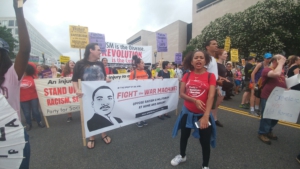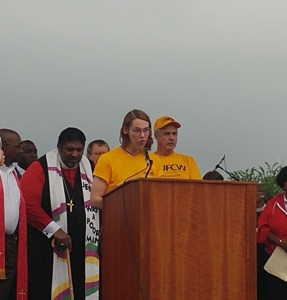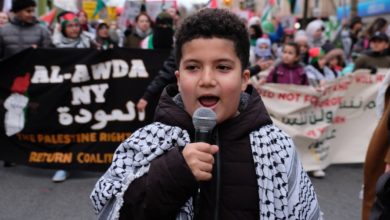
“This is not a commemoration of what happened 50 years ago,” Reverend William Barber II said before a crowd of 10,000 Saturday on the National Mall in Washington, DC. “This is a reenactment and reinauguration.”
Barber, 54, who is credited with having restarted the Poor People’s Campaign last year, hails from North Carolina and has a lifetime of community activism on the NAACP’s Political Action Committee.
Barber was referring to a sequence of events in the original Poor People’s Campaign that unfolded a half-century ago when a group of 3,000 poor people set up a protest encampment they called “Resurrection City” on the same part of the National Mall where the June 23 rally was held. Established in May following Coretta Scott King’s two-week protest in Washington, D.C. for an “Economic Bill of Rights,” the protest encampment’s permit expired June 23, 1968, and the Metropolitan Police wasted no time evicting them with extreme violence, summoning a thousand police and firing tear gas into the encampment, arresting nearly 300 of its residents. DC Mayor Walter Washington declared a state of emergency and had the National Guard patrolling the streets before the episode was concluded. It it had only been weeks since much of the city had burned in an angry uprising following Dr. King’s assassination in early April.
The Poor People’s Campaign was Dr. Martin Luther King, Jr.’s final project, when following the civil rights victories of 1964-66,
he turned his attention to economic inequality and the growing war in Vietnam and what he called the “giant triplets of racism, extreme materialism, and militarism.” It was this shift in focus that made him persona non grata to the U.S. government, and why he was assassinated in 1968.
The large-scale protest in Washington was conceived of by King and his associate Stanley Levison, who noted the possibility that “mass civil disobedience” could “use rage as a constructive and creative force” in northern cities, following the uprisings in Newark, NJ and Detroit, MI, in July 1967. “If they are developed as weekly events at the same time that mass sit-ins are developed inside and at the gates of factories for jobs, and if simultaneously thousands of unemployed youth camp in Washington, as the Bonus Marchers did in the thirties, with these and other practices, without burning a match or firing a gun, the impact of the movement will have earthquake proportions,” Levison and King wrote in “The Crisis in America’s Cities.”
Like King and Levison, Barber and his associate, the Rev. Dr. Liz Theoharis, conceived in the fall of 2017 of a new campaign “of sustained moral direct action as a way to break through the tweets and shift the moral narrative. We are demonstrating the power of people coming together across issues and geography and putting our bodies on the line to the issues that are affecting us all,” as the movement’s fundamental principles state.
Shifting the moral narrative
Barber and Theoharis readily identify their cause with that of the Old Testament prophet Isaiah, whose preachings to help the poor and form a just code of laws are believed by Christians to prefigure the moral message of Jesus. Theoharis quoted one verse in particular in which Isaiah calls out those who pretend to be righteous and moral, but in fact ignore the instruction to “to loose the chains of injustice and untie the cords of the yoke, to set the oppressed free and break every yoke” (Isaiah 58:6).
Like Isaiah, the campaign aims “to shift the distorted moral narrative” away from that claimed by the Christian Right, the so-called Moral Majority, back “to one that is concerned with how our society treats the poor, those on the margins, the least of these, women, LGBTQIA folks, workers, immigrants, the disabled and the sick; equality and representation under the law; and the desire for peace, love and harmony within and among nations.”
This, Theoharis urged June 23, “will raise up the age-old foundations,” as Isaiah promised, and resolve the contradiction between America’s rhetorical promise of freedom, equality and democracy with its reality of bigotry, apartheid and repression.
Liberation News spoke with Kenzie Raulin, an activist from Silver Spring, Maryland, just outside Washington, D.C., about the 40-day campaign leading up to the national rally. Activists received training in nonviolent protest practices during “Moral Mondays” and had “teach-in Tuesdays” in which they studied different aspects of Dr. King’s thought by learning from local experts in those subjects. Causes such as the necessity of a living wage, affordable housing, education and anti-war activism were common topics.
All that training was then put to use in mass civil disobedience actions. Such actions have focused on key institutions being protested
such as the U.S. Supreme Court, U.S. Department of Health and Human Services, and houses of legislature where unjust laws are passed.
Morality is a common theme of the Poor People’s Campaign, whose tagline is “A National Call for Moral Revival,” and it featured prominently in this national rally. Protesters gathered on a cool, misty morning on the vast expanse of grass and sand that stretches from the U.S. Capitol building to the Washington Monument to hear speakers on a variety of topics.
“We need to get beyond Trump”
Barber urged a nonpartisan approach to politics, insisting that the question was not “Republican or Democrat,” but “right versus
wrong.” The campaign has actively eschewed politicians, does not seek to shepherd activists into voting for either party, and refuses to allow any office-holding politician to speak at its events or to represent the movement in any capacity. In that vein, Raulin urged, “We need to get beyond Trump.”
With the emphasis on grassroots, bottom-up organizing that empowers the powerless and gives voice to the voiceless, the labor unions
who came out in force did not have their presidents give long speeches extolling the virtues of the hard-working laborer, but rather let
rank and file members speak about their challenges and the vision they saw for the movement.

Cortne Lee Duval from Asheville, North Carolina, spoke on behalf of the United Food and Commercial Workers union. Duval, a trans woman, described to Liberation News the challenges of organizing labor at the Earth Fare grocery store where she works, noting that many workers simply don’t know what a union can do for them, and thus appear apathetic to the question of unionization.
Further complicating issues is that North Carolina is a “right-to-work” state, which really means “right to fire.” Unions are barred from forming closed shops under right to work laws, drastically weakening the organizational and collective bargaining capabilities of labor unions. Duval noted that under such an arrangement, not every employee in the store has to join or support the union, but they all nonetheless benefit from any contract the union does sign with their employer.
Addressing the crowd, Duval noted that workers are the source of wealth and described the necessity of organizing and fighting back, especially in a town like Asheville. Duval makes $10 an hour as a baker, which is just barely half the cost of living in the city, one of the highest in the nation. She warned that a fight was coming whether we want it or not, that if we have better material conditions then the world can become better and people can become better, if we struggle and win together.
Saurav Sarkar is a research coordinator at the Institute for Policy Studies, which partnered with the PPC to publish a report on the last 50 years of poverty, racism, militarism and environmentalism. Sarkar told Liberation News the purpose of this study was to provide an empirical basis for the campaign’s claims. For example, one of their findings was that 43 percent of the U.S. population, or 140 million people, are poor/low-income. Sarkar said this combined term comes from their updated metrics for poverty, which they believe are more accurate than those used by the U.S. Census. Sarkar said the federal poverty line, which doesn’t account for taxes, benefits or costs of
living, is “insultingly low” and “inaccurate,” so their metric judged up to 200 percent above the line to get a more accurate picture of who is really struggling in the U.S..
This isn’t the picture of poverty the mainstream media will show you, Sarkar emphasized, and they certainly haven’t talked about either the PPC or the Institute for Policy Study’s findings.
A large number of labor unions took part in the rally, including AFSCME, UFCW, SEIU and AFGE. Duval said UFCW brought 500 people by itself, decked out in yellow shirts with the union’s name on it. Other groups included Georgia Latino Alliance for Human Rights, Put People First PA, CWA, and Health Justice.
The Party for Socialism and Liberation participated as well, bringing its radical, anti-capitalist message to the rally and march. Many
participants were excited by the PSL’s presence, eagerly wielding PSL materials and signing up.
Following the rally, the myriad of protesters marched toward the U.S. Capitol via Independence Avenue. The sun having come out, large
numbers of tourists lined the sides of the road and filed out of the Smithsonian museums to see and cheer on the march. The protest wound its way up to the foot of Capitol Hill, where a police line formed a barrier barring our access to the Capitol building’s steps and west lawn. However, the purpose of the march being a show of force – certainly “an unsettling force” for Capitol Police, as Rev. Theoharis would style it – the march turned back to its rally grounds on the Mall.






